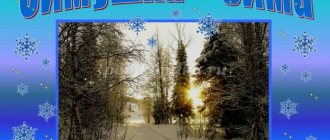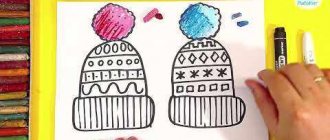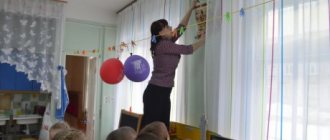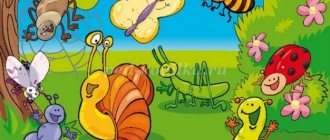Abstract of GCD senior group “Winter”
Goal: to consolidate and generalize children’s knowledge about winter and natural phenomena with the help of works of Russian poets and artists. Tasks:● trace the relationship between living and inanimate nature, human life and the seasons; ● develop cognitive interest; ● to develop the ability to see the beauty of the surrounding world; ● cultivate love for native nature and ecological culture; ● cultivate a culture of dialogue: the ability to listen carefully to your interlocutor, not to be distracted, not to interrupt, to answer questions, to give examples; ● develop attention, observation, visual perception, logical thinking. Equipment for the educational process: illustration “Winter Forest”, pictures for game exercises “Snowmen”, “Confusion”; a selection of poems by Russian poets, riddles about winter, winter phenomena; Progress of the activity: The teacher gathers the children around him and reads them a poem: White fluffy snow is spinning in the air. And quietly falls to the ground, lies down
— Guys, what time of year did I read the poem about? - Why do you think about winter? - That's right, only in winter there is snow. Today I invite you to go on a journey to the Queen - winter. Imagine that we have this magic sleigh and we go on a visit on it. Educator. Here we are, guys, listen to the riddle. Troika, troika has arrived, The horses in that troika are white, And in the sleigh sits the queen - White-skinned, fair-faced. How she waved her sleeve - She covered everything with silver! What queen do you think this riddle is talking about? Why is winter called the queen? Do you think the definitions “white-skinned” and “fair-complexioned” are appropriate for winter? Why? Which three did winter arrive on? What kind of horses are in this trio? That's right, it's the winter months. Remember their names. Yes, winter is the queen of three months: December, January, February. What winter month is it now? The Queen - winter - comes out to the guys. Queen - Winter: Hello, my friends! I'm glad to see you all. Do you want to see a real Russian winter? (Children's answers). Then watch! Music sounds, the Queen - winter scatters “snow” everywhere. Do you like it? Our Russian winter is like a fairy tale kingdom. Listen to how Russian poets write about the beauty of the winter forest. Winter sings and calls, The shaggy forest lulls with the ringing of the pine forest. All around with deep melancholy. (S. Yesenin.) White fluffy snow swirls in the air and quietly falls to the ground and lies down. And in the morning the Field turned white with snow, as if everything had covered it with a shroud. The dark forest covered itself with a wonderful hat, and fell asleep under it, soundly and soundly. (I. Surikov.) How beautifully poets speak about nature, about winter. Do you guys know poems about winter? (Children read poems about winter.) Well done! Can you solve riddles? Try to guess my riddles, it's very difficult! - The white tablecloth covered the whole world. (Snow.) There’s a mountain in the yard, and water in the hut. (Snow.) - The guest stayed - he paved the bridge, It’s warm for the fish to live in the winter; — The roof is thick glass. (Ice.) The old man at the gate dragged away the warmth. He doesn’t stand and doesn’t order him to stand. (Frost.) And not snow, not ice, but will remove the trees with silver. (Rime.) Well done, guys, you guessed correctly. For this I give you our winter as a souvenir! Queen Winter gives the children the painting “Winter Forest” and leaves. Educator: Look carefully at the picture. What colors did the artist use to paint it? (Children's answers.) Tell me, how has inanimate nature changed in winter? What was the weather, sky, sun like? (Children's reasoning.) Who else do we see in the picture in the winter forest? How has the life of animals and birds changed in winter? What happened to the plants? (Children’s answers.) Has anything changed in our lives, in people’s lives, with the arrival of winter? We dress warmly in winter, insulate our homes, and also celebrate many wonderful holidays. What winter holidays do you know? (New Year, Christmas, Maslenitsa.) What games do you like to play in winter? (Children call winter games.) Let us play now. Physical education moment. We walk through snowdrifts, Through steep snowdrifts. Raise your leg higher, pave the way for others And now sideways, sideways, each other running, The leg was catching up with the leg, Still jumping sideways after it. I fell behind and caught up. - Stop ! - said. - I'm tired. The leg was catching up with the leg, and kept jumping sideways after it. Educator. Guys, it's time for us to show off our wits. — Exercise “Snowmen”. Task: compare two snowmen, find the difference between them. — Didactic game “Name the signs of winter” Educator: Tell me guys, what is winter like? Cold…. Children: Cold Teacher: Frost - .... Children: Frosty Educator: Cold -…. Children: Cold Teacher: Blizzard - .... Children: Blizzard Teacher: Ice - .... Children: Ice Teacher: Snow - .... Children: Snezhnaya Summing up. Guys, what did we talk about today, what did we do in class? What did you especially like or remember? Listen to another beautiful riddle about winter. Even though she herself is snow and ice, And when she leaves, she sheds tears. Surprise moment. The children and their teacher find the Winter Queen's ice box with a note in which she thanks them for knowing so much about winter and gives them sweet candies.
Summary of an integrated lesson in the senior group of kindergarten “Hello, Zimushka-winter!”
Summary of an integrated lesson in the senior group “Hello, Zimushka-winter!” Target:
— Development of creative initiative and independence of children, the desire to apply existing knowledge and skills in practice.
Objectives: Educational:
- enrich the emotional and aesthetic perception of preschool children through the poetic word and music;
- to develop the ability to dramatize simple poetry: to combine movement and text in the role - to introduce children to and help them master unconventional drawing techniques (with a sponge on a stencil); Developmental:
- develop creative imagination, fantasies, thinking, memory, the ability to see, feel, discuss winter fun;
Educational:
- cultivate positive relationships in children, feelings of partnership, friendship and responsibility.
Materials:
costumes of Snowman, Wolf, hats of hares, Winter, oilcloth, sponges, brushes, baths of gouache, stencils of wolves, hares, snowmen, napkins, three sheets of whatman paper in A1 format, with a prepared background.
Preliminary work:
memorizing poems about snowmen, songs, dances, expressive reading of memorized poems.
Progress of OOD Children enter the music room to the music, forming a circle. Educator:
Winter rolled over us with snowy sleeves, And snowflakes fell on the trees and houses.
We will fight in the snow, We love to ride down the mountain And that’s why we really like it Children (in unison):
I really like winter!
Educator:
Since you like winter, let's sing a funny song about it.
(children stand up scattered and perform a song with movements) “Winter Song” (music - V. Vitlina, words - T. Volchina) 1 child: Oh, you're winter - winter, We're glad that you came. Let's start a round dance and sing a winter song. Round dance “Hello, winter-winter! "(music - A. Filippenko, words - T. Volchina). Child 2: (reads a counting rhyme, chooses a driver for the game) We begin to play, We will count everyone in a row: One, two, three, four, five, We will choose winter. (The selected child puts on a Winter hat) Game “Winter and Children” (author unknown) Children (in chorus): One, two, three, four, five, Come on Winter, hurry up and play. (Winter in the center of the circle) Winter, winter, where have you been? (Children approach Winter, narrowing the circle, Winter, winter, where have you been? expand the circle, then repeat the movements that Winter shows) Winter: She carried cold in a bag, (Winter walks, depicting a bag over her shoulder, shook the cold on the ground, shakes her hands away from herself, her arms and legs are chilly, she rubs her shoulders with her palms, shifts from foot to foot, she lets the cold into the hut, blows, makes smooth movements with her hands forward, all the roads of the earth smoothly shakes her hands below, and the snowdrifts raises her hands up, through sides returns them to their original position) Children (in chorus): Oh, you're Winter-winter, (Children narrow the circle, It was a fierce winter, expand the circle, I ask you, stretch their arms forward, Don't freeze me! They shake their fingers) After these words, the children They run in a circle towards the chairs, Winter tries to catch up and “freeze” as many children as possible. Educator:
And now, I’ll tell you a riddle.
Children sculpt in winter a Miracle with a round head: Who will deftly place on whom, A riddle - The mouth is an arc, and the nose is a carrot, And two eyes are coals, And two hands are made from branches. The sun came out, and he wilted. Who is this? (Snowman) We taught you a lot of poems about snowmen. Let's try to not only read them now, but also show them (dramatization of poems) “Snowman” (author - V. Egorov) - 3 boys, Come on, my friend, be brave, my friend, Roll your snowball in the snow. He will turn into a snowball, And the ball will become a snowman. His smile is so bright! Two eyes, a hat, a nose, a broom. But the sun will burn slightly - Alas! - and there is no snowman. “Snowman” (author - T. Shorygina) - 2 girls and a boy, My friend Katya and I are rolling big time. We make a snowman from a fluffy ball. In a white fur coat, With coals instead of eyes, Smiling as if alive, the Snowman looks at us. We will give him a broom, We will mold a fluffy collar, Let a janitor - a snowman - walk along the streets of the village. Educator:
Now let's listen to a story in which another snowman showed himself bravely.
“Snowman” (author - I. Gurina) - (reading a poem with dramatization by roles: author, 5 hares, snowman, wolf (8 children) White bunnies were sitting on the stump of an old fir tree. - What should we do with this? - They reasoned sadly brothers." - And we played in the snow, And rode on the slide! And let's, maybe, sculpt Baba in the snow! Exactly! We got down to business, And the work began to boil! Five of the bunnies were rolling a huge snowball. The second one was easier, The third one was the younger brother blinded! The hands are two large sticks, And the hairstyle is made of a washcloth. The cheerful nose is made of carrots, The eyes and eyebrows are made of knots. The mouth and cheeks are made of rowan, The hat is made of a large basket. The bunnies are jumping around: - Hello, hello, snowy friend!" He suddenly nodded his head and winked at the bunnies: "Would you like the bunnies to play hide and seek with me?" The elder twists his head: "Our snowman is alive!" At that time, behind the bushes, a gray wolf was clanking his teeth. Only he jumped to the bunnies! And a snowman came along! The wolf was terribly frightened, The snowman chased him. What kind of snowy beast is this wandering through the forest now? The wolf moans quietly out of fear, He won’t touch any more hares, After all, the brothers have a new friend, He is stronger than everyone around! Educator:
After watching this story, you probably really wanted to draw it on paper.
But first, let's do the wonderful "I Draw" dance. Dance “I Draw” (to the music “Winter” disc “New Year’s Snowflakes” Publishing House Vest - TDA Moscow) Educator:
Now we will begin to draw a winter story about a brave snowman in an unusual way using stencils and sponges. You need to press the stencil tightly with your left hand, and apply paint with your right hand using a sponge. You also need to choose 2 people who will complete the winter landscape with a brush of white paint. Divide into three subgroups and get to work. Children draw to the music of P. I. Tchaikovsky from the cycle “The Seasons”; after finishing drawing, the children examine the drawings. Educator: Children, what works did you like and why? (children's answers) Well done, guys, you have created wonderful illustrations for the winter story with the snowman. Tell me, children, what did you like about the lesson? (children's answers). Well, now let’s smile at each other and get ready for a walk in a good mood, where we’ll come up with new stories with crafts made from snow.




